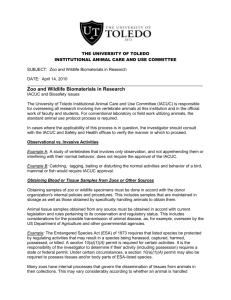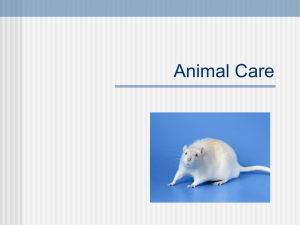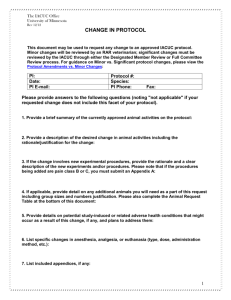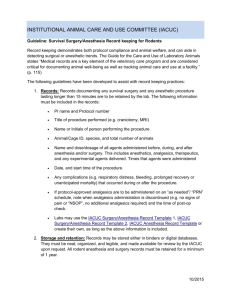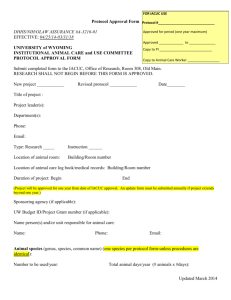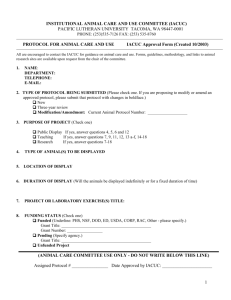SECTION 2 – Project Overview
advertisement
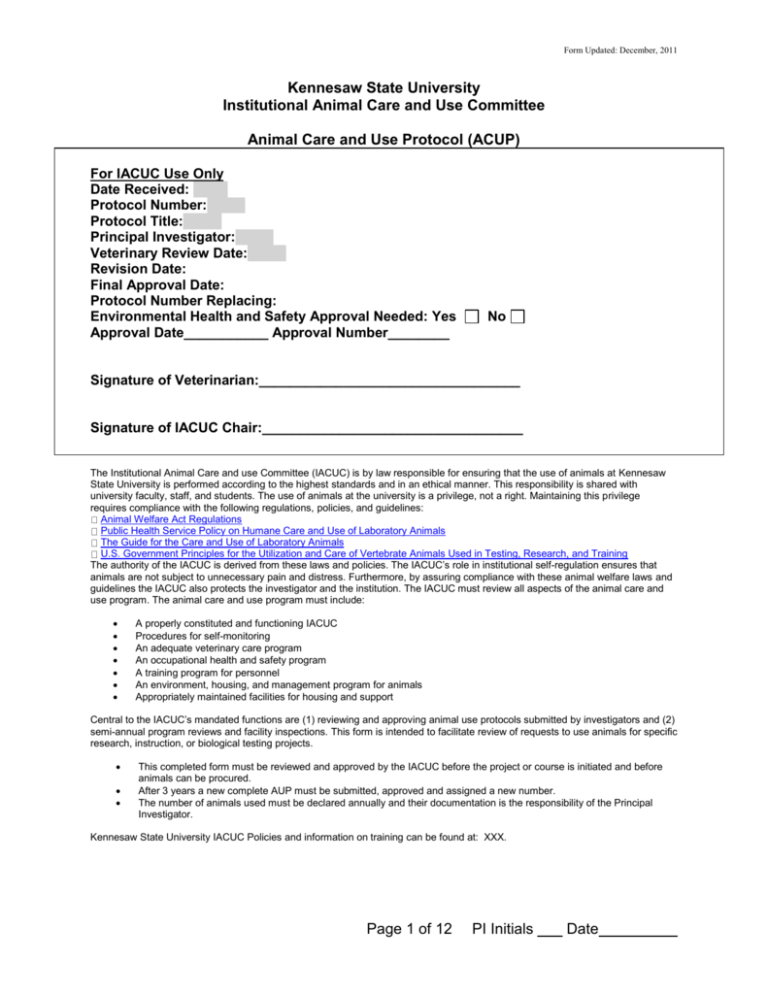
Form Updated: December, 2011 Kennesaw State University Institutional Animal Care and Use Committee Animal Care and Use Protocol (ACUP) For IACUC Use Only Date Received: Protocol Number: Protocol Title: Principal Investigator: Veterinary Review Date: Revision Date: Final Approval Date: Protocol Number Replacing: Environmental Health and Safety Approval Needed: Yes Approval Date___________ Approval Number________ No Signature of Veterinarian:__________________________________ Signature of IACUC Chair:__________________________________ The Institutional Animal Care and use Committee (IACUC) is by law responsible for ensuring that the use of animals at Kennesaw State University is performed according to the highest standards and in an ethical manner. This responsibility is shared with university faculty, staff, and students. The use of animals at the university is a privilege, not a right. Maintaining this privilege requires compliance with the following regulations, policies, and guidelines: Animal Welfare Act Regulations Public Health Service Policy on Humane Care and Use of Laboratory Animals The Guide for the Care and Use of Laboratory Animals U.S. Government Principles for the Utilization and Care of Vertebrate Animals Used in Testing, Research, and Training The authority of the IACUC is derived from these laws and policies. The IACUC’s role in institutional self-regulation ensures that animals are not subject to unnecessary pain and distress. Furthermore, by assuring compliance with these animal welfare laws and guidelines the IACUC also protects the investigator and the institution. The IACUC must review all aspects of the animal care and use program. The animal care and use program must include: A properly constituted and functioning IACUC Procedures for self-monitoring An adequate veterinary care program An occupational health and safety program A training program for personnel An environment, housing, and management program for animals Appropriately maintained facilities for housing and support Central to the IACUC’s mandated functions are (1) reviewing and approving animal use protocols submitted by investigators and (2) semi-annual program reviews and facility inspections. This form is intended to facilitate review of requests to use animals for specific research, instruction, or biological testing projects. This completed form must be reviewed and approved by the IACUC before the project or course is initiated and before animals can be procured. After 3 years a new complete AUP must be submitted, approved and assigned a new number. The number of animals used must be declared annually and their documentation is the responsibility of the Principal Investigator. Kennesaw State University IACUC Policies and information on training can be found at: XXX. Page 1 of 12 PI Initials Date ___ Form Updated: December, 2011 SECTION 1 – Basic Protocol Information Principal Investigator/Instructor: Faculty Rank: The investigator/instructor must be a member of the faculty or a research associate with parenthetical rank. Prior animal activity as Principal Investigator (PI) at KSU: yes no Primary Department: Office Address: Include mail code, if applicable. Phone: E-mail Address: Species Involved: Only one species may be listed per ACUP. Project Title: New ACUP Renewal If renewal, indicate ACUP number : Staff group, including the PI, co-investigators, technicians, and students who will be directly involved in carrying out the work; Note that staff other than the main investigator may not amend ACUPs. Name Position Phone Years of work with this species and techniques Note: If any of the individuals listed above have less than one year of experience working with this species, please describe on one additional page how they will be or have been trained. Scientific/Educational Review and Sponsorship of Project: Project is funded: internally externally externally (pending) If the animal procedures proposed in this ACUP are externally funded, please provide the name of the grant agency: If research is externally funded, was scientific peer review part of the approval? yes no 1.1 General Animal Information Page 2 of 12 PI Initials Date ___ Form Updated: December, 2011 1.1.1 Over a period of three (3) years I would like to use a total of animals. 1.1.2 I would like to begin using these animals on (date): 1.1.3 I will obtain animals from (name of supplier). Will there be on-site breeding? (number) yes no Note: A separate ACUP is required when breeding is done to maintain a separate stock used for several projects. 1.2 Three Year Renewal If this is a 3 year renewal, please answer the following questions. If not, please skip to the next section. 1.2.1 1.2.2 1.2.3 1.2.4 What is the number of the protocol this is replacing? Do you presently have any live animals under this number? If yes, will these animals be transferred to your new protocol once it is approved? As this is a 3-year renewal, the IACUC requests that you provide a very brief description of the outcomes of the work conducted under the existing approval. 1.3 Location of work on project 1.3.1 1.3.2 1.3.3 Will any aspect of the study (course) or animal husbandry be conducted at another institution? If so, please name the institution: If yes, please provide the PHS Assurance number of the institution where this work will occur. Has this proposal been approved by the IACUC of that institution? 1.4 Veterinary Care and Consultation: Principal Investigators may discuss the proposed project with the Veterinarian before submission of the application to the IACUC. Procedures involving more than momentary or slight pain or distress (USDA Pain Category “D” or “E”) must be discussed with the Veterinarian in the planning of the research project. All protocols and amendments will be sent to the Veterinarian for review of animal care issues after submission. SECTION 2 – Project Overview 2.1 Objective and Significance Please provide a brief statement, in LAY TERMINOLOGY understandable by someone with a high school education, with no acronyms or scientific jargon, outlining the objective of the procedures of this protocol. Please follow this with a brief statement about how your work might be relevant to (or contribute to) human/animal well-being or the expansion of knowledge. Begin with a broad statement concerning the overall problem (e.g., “Pancreatic cancer kills ~50,000 Americans each year. We are addressing this problem by ….”). Include a statement of your experimental hypothesis or objectives. Please do not submit your grant proposal abstract for this section. Define all abbreviations the first time they are used and explain medical terms. (“Why are you are doing this experiment with animals and what do you propose to learn?”) You will be asked to provide a scientific summary of the project in a later section. Page 3 of 12 PI Initials Date ___ Form Updated: December, 2011 2.2 Justification for the Use of Animals Please justify the use of animals. Provide a brief statement justifying your use of animals in the proposed project by explaining why you must use animals in this work. SECTION 3 – Animal Use Category Information If the answer to any of the following questions is YES, please provide a brief explanation. 3.1 Will any technique be performed which will involve prolonged physical restraint (> 30 minutes) other than routine caging, housing, tanks, and/or handling? 3.2 Will any substance such as Complete Freund’s Adjuvant or other adjuvants be injected which could cause chronic inflammation and/or pain? If yes, describe what will be used, volumes, and the schedule for the injections. 3.3 Will it be necessary for live animals to be removed from the animal facility? 3.4 Will this experiment involve stress, pain, or abnormal behavior in live animals, which cannot be alleviated with drugs because their use would interfere with the research goal? 3.5 Will animals be subjected to more than one major survival surgical procedure? Major survival surgery is defined as the penetration of a body cavity with anything larger than a needle or a surgical procedure that results in permanent loss of function. 3.6 Will any adverse effects or overt signs of illness be expected? SECTION 4 – USDA Animal Use Category Classification USDA Classifications and Examples of Pain Categories: Classification B: Animals being bred, conditioned, or held for use in teaching, testing, experiments, research, or surgery, but not yet used for such purposes. Examples: Breeding colonies - Includes parents and offspring. Animals held under proper captive conditions or wild animals that are being observed. Classification C: Animals upon which teaching, research, experiments, or tests will be conducted involving no pain, distress, or use of pain-relieving drugs. Examples: Procedures performed correctly by trained personnel such as the administration of electrolytes/fluids, administration of oral medication, blood collection from a common peripheral vein per standard veterinary practice or catheterization of same, standard radiography, parenteral injections of non-irritating substances. Euthanasia performed in accordance with the recommendations of the most recent AVMA Panel on Euthanasia, utilizing procedures that produce rapid unconsciousness and subsequent humane death. Manual restraint that is no longer than would be required for a simple exam; short period of chair restraint for an adapted nonhuman primate. Classification D: Animals upon which experiments, teaching, research, surgery, or tests will be conducted involving accompanying pain or distress to the animals and for which appropriate anesthetic, analgesic, or tranquilizing drugs will be used. Examples: Page 4 of 12 PI Initials Date ___ Form Updated: December, 2011 Surgical procedures conducted by trained personnel in accordance with standard veterinary practice such as biopsies, gonadectomy, exposure of blood vessels, chronic catheter implantation, laparotomy or laparoscopy. Blood collection by more invasive routes such as intracardiac or periorbital collection from species without a true orbital sinus such as rats and guinea pigs. Administration of drugs, chemicals, toxins, or organisms that would be expected to produce pain or distress but which will be alleviated by analgesics. Classification E: Animals upon which teaching, experiments, research, surgery, or tests will be conducted involving accompanying pain or distress to the animals and for which the use of appropriate anesthetic, analgesic, or tranquilizing drugs will adversely affect the procedures, results, or interpretation of the teaching, research, experiments, surgery, or tests. Examples: Procedures producing pain or distress unrelieved by analgesics such as toxicity studies, microbial virulence testing, radiation sickness, and research on stress, shock, or pain. Surgical and postsurgical sequella from invasion of body cavities, orthopedic procedures, dentistry or other hard or soft tissue damage that produces unrelieved pain or distress. Negative conditioning via electric shocks that would cause pain in humans. Chairing of nonhuman primates not conditioned to the procedure for the time period used. 4.1 Selection of Pain Category Please classify the project according to the level of perceived pain / stress / distress experienced by the animal(s). Animals must be claimed under the highest class involved at any point prior to euthanasia or release. Highest Pain Category within this protocol: (enter B, C, D, or E) 4.2 Justification of Pain Category “E” If category E is selected, please provide a scientific justification for withholding pain and/or distress relief. 4.3 Monitoring of Animal Pain and Comfort Levels 4.3.1 4.3.2 4.3.3 Who will be responsible for monitoring the animals for pain and/or distress during the experimental procedure(s)? How will the comfort level of the animals be determined? In the event that an animal needs to be euthanized or removed from the experiment, please list the criteria for the decision. Describe the humane endpoint criteria to be applied and the frequency of monitoring for these humane endpoints. 4.3.4 Who will determine this action? Section 5 – Method(s) of Euthanasia 5.1 Describe in detail the method of euthanasia (if any) you will use. If the method involves the use of pharmaceuticals, please specify agent, dose, and route of administration. Please note that methods of euthanasia must be in accordance with the most current American Veterinary Medical Association Panel on Euthanasia. References must be cited to justify deviations from this document, or to justify use of cervical dislocation or decapitation without anesthesia. 5.2 5.3 How will death be confirmed? How will remains be disposed? Page 5 of 12 PI Initials Date ___ Form Updated: December, 2011 Section 6 – Alternatives and Non-duplication 6.1 Consideration of Alternatives for Category “D” or “E” Animal Use. The Public Health Service Policy and the Animal Welfare Act require assurance that there is appropriate consideration of alternatives to procedures that can cause more than slight or momentary pain or distress in animals (Class “D” and ”E” procedures), consistent with sound research design. Alternatives include methods that (1) refine existing tests by minimizing animal distress, (2) reduce the number of animals necessary for an experiment, or (3) replace whole-animal use with in vitro or other tests. Alternatives or alternative methods include use of non-animal systems, less sentient animal species or techniques that lessen or eliminate pain or distress such as chemical instead of physical castration or reducing the size of implants and incisions. 6.1.1 Literature search for alternatives to painful procedures If you chose category “D” or “E” above, please do literature searches using the broadest database for your area of study, and provide a brief summary of the results obtained to verify that you investigated the use of alternatives to painful or distressful procedures. Appropriate databases may include: PubMed Web of Science, PsyInfo, AltWeb, NLM Gateway, AVAR, Galileo, AGRICOLA or AWIC. If you have not selected either category D or E, skip to section 6.2. 6.1.1.1 Name of the databases used Date the databases search(es) were done Did the search cover the entire date range of the databases with no restriction on dates? Yes No (If No, provide dates covered by the search(es) below) Dates covered by the databases search(es) 6.1.1.2 Search keyword(s) used : include number of hits for combinations of terms. You must use ‘alternative’ and ‘animal welfare’ in the search combinations (i.e., Alternative AND Obesity; Alternative OR Animal Welfare AND Obesity etc.) 6.1.1.3 Summarize the hits below. (Note: this should be a general summary. You do not need to go into the details of each hit but rather summarize hits by relevant groups) 6.1.2 Explain what alternatives exist in place of using animals for this protocol and provide a justification if these cannot be used. 6.1.3 Other Sources of Information on Alternatives to Painful Procedures 6.1.3.1 Consultation with Experts: (Names, credentials, and dates) 6.1.3.2 Scientific Meetings: Specify 6.2 Consideration of non-duplication Page 6 of 12 PI Initials Date ___ Form Updated: December, 2011 6.2.1 Please provide a written assurance that the proposed work is not unnecessarily duplicative. SECTION 7 – Justification for Animal Species Selection 7.1 7.1.1 7.1.2 7.1.3 7.1.4 Animal characteristics Species Name: Strain (if any): Age: Sex: 7.2 This species has been selected because (check all that apply) Previous work in the biomedical literature validates the use of this species as an animal model for this disease, biological process or mechanism, or for its informative phylogenetic position. This is the lowest sentient species that provides appropriate size, tissue or anatomy of the proposed work. There is a large body of existing data that would need to be repeated if another species was used instead. Available reagents or research tools necessary for this research are unique to this species. Characteristics of this species make it uniquely suited for the proposed research. Explain. Other (Explain) SECTION 8 – Animal Use Narrative 8.1 Please describe in narrative form all experimental or instructional procedures to be performed on the animals. Please note that it is not necessary to provide the details already provided elsewhere in the protocol (e.g. procedure descriptions, volumes of blood collected, dosages, routes of administration, use of aseptic procedures, etc.). However, it is important that one is able to ascertain what procedure or set of procedures is conducted on each group of animals. Include the time frames and intervals between procedures and describe the procedures in the order they will be performed. SECTION 9 – Justification for the number of animals that will be used Page 7 of 12 PI Initials Date ___ Form Updated: December, 2011 9.1 Group sizes are expected to represent the minimum number of animals that are needed to achieve the scientific or instructional objectives. Please indicate all the methods used to determine these numbers. Statistical tools, such as power analysis, were employed to determine appropriate group sizes to ensure statistically valid outcomes. Previous experience with this experimental paradigm indicates this is the minimum number of animals needed. Consultation with a biostatistician This is a pilot study used to determine feasibility before proceeding with larger, more tightly controlled experiments. This is an instructional activity. This is the minimum number of animals needed based on class size and optimal student to instructor ratios. Other (Explain) Section 10 – Procedures Please describe in detail all of the procedures you will be doing with animals in the appropriate grey boxes below. Indicate whether infectious agents, chemical or physical restraint, radioactivity or adjuvants will be used. Describe possible/known side effects of each procedure. 10.1 Non-surgical procedures that will be used under this protocol. Non-surgical Procedures Description and Guidance Describe each non-surgical procedure that will be used and state the maximum number of times each procedure will be done to any animal. 10.2 Surgical procedures that will be used under this protocol. Surgical Procedures Description and Guidance Please indicate if surgical procedures will be used under this protocol Yes No (If No, then skip to Question 11) 10.2.1 Describe surgical procedures that will be used. Indicate type of surgery, provide a general description and indicate if it will be survival or non-survival surgery. Describe pre- and post-op procedures and monitoring. State whether analgesics will be given preor post-procedurally. If analgesics are not used justify why this is the case. If sutures or wound clips will be used, indicate when they will be removed. SECTION 11 – Substance Administration 11.1 Substance Description If anesthetics, analgesics, or other substances are administered during the conduct of a procedure, please describe: 11.1.1 11.1.2 11.1.3 11.1.4 11.1.5 Name of Substance: Dose: Route of Administration: Frequency of administration: If applicable, state how anesthetic depth will be assessed Page 8 of 12 PI Initials Date ___ Form Updated: December, 2011 SECTION 12 – Personnel and Their Experience and Training List the experience and/or training of the personnel and the procedures that each will conduct below. If training has not been completed, visit XXX and complete the XXX training course prior to submitting this protocol application. Principal Investigator: Name: Phone number and location: Procedures will do on animals: Years of related experience: KSU training completed: Note: You can copy and paste the set of questions as needed to list additional personnel. Postdoctoral personnel: Name: Phone number and location: Procedures will do on animals: Years of related experience: KSU training completed: Graduate Students: Name: Phone number and location: Procedures will do on animals: Years of related experience: KSU training completed: Technicians: Name: Phone number and location: Procedures will do on animals: Years of related experience: KSU training completed: Undergraduates: Name: Phone number and location: Procedures will do on animals: Years of related experience: KSU training completed: SECTION 13 – Hazard Use 13.1 Are you working with infectious agents and/or biologically-derived toxins? No Yes I have approval from Environmental Health and Safety Date Approval # 13.1.1 Describe all special precautions recommended for personnel who handle animals, equipment, or do housekeeping. Describe how contaminated caging or tanks, bedding, and equipment should be handled. Page 9 of 12 PI Initials Date ___ Form Updated: December, 2011 13.2 Does the project use any recombinant DNA (i.e. cloning/expression systems, viral vectors, etc.) material in animals? No Yes I have approval from Environmental Health and Safety Date Approval # 13.2.1 Describe all special precautions recommended for personnel who handle animals, equipment, or do housekeeping. Describe how contaminated bedding, cages or tanks or equipment should be handled. 13.3 Will any carcinogenic or toxic compounds to be used in animals? No Yes I have approval from Environmental Health and Safety Date Approval # 13.3.1 Describe all special precautions and training recommended for personnel who handle animals, equipment, or do housekeeping. Describe how contaminated caging or tanks, bedding, and equipment should be handled. 13.4 Will any radioactive compounds be administered to the animals? No Yes I have approval from Environmental Health and Safety Date Approval # 13.4.1 Describe all special precautions recommended for personnel who handle animals, equipment, or do housekeeping. Describe how contaminated caging, bedding, and equipment should be handled. 13.5 Will Controlled Substances be used? No Yes 13.5.1 Do you have a Controlled Substance Permit? No Yes SECTION 14 – Animal Housing and Husbandry 14.1 Will you breed these animals? No Yes Please address the following: describe method of mating (harem, monogamous, et cetera); describe age of weaning; describe genetic monitoring and methods to assure inbred / outbred status; justify breeding versus obtaining commercially. If only one sex of offspring will be used in experiments, please justify. Page 10 of 12 PI Initials Date ___ Form Updated: December, 2011 14.2 Do the animals require housing other than standard caging/bedding or tanks/water? No Yes (List housing required and explain below) 14.3 Do the animals require special care? No Yes (List special care and explain below) 14.4 Do the animals require diet other than the standard diet commonly used for this species? No Yes (List diet and explain below) 14.5 Will animals remain outside an IACUC approved Animal Housing Area for more than 12 hours? No Yes (List where and explain below) 14.6 Will animals be transported outside of an IACUC approved Animal Housing Area (e.g. to your lab or off campus)? Yes I agree to adhere to the KSU Animal Transportation Policy [link] I request a deviation from the KSU Animal Transportation Policy [link] Please state the deviation and provide a justification for the deviation below. No 14.7 Will animals undergo experimental manipulations outside the IACUC approved Animal Housing Area? No Yes (List where and explain below) 14.8 Can your animals be provided environmental enrichment? Enrichment options can be found at: KSU Animal Enrichment Guide [link] No (Explain below) Yes (List enrichment requested below) 15 Certification of Compliance: As the individual responsible for this project, I confirm that the information contained in this ACUP is true and accurate and, to the best of my knowledge, conforms with the procedures described in the NIH Guide for the Care and Use of Laboratory Animals, with PHS policy, the Animal Welfare Act, and the KSU IACUC Policies and Procedures Manual. I have considered alternatives to the biological models used in this project, and have found these other methods unacceptable on scientific or educational grounds. I confirm that this project does not unnecessarily duplicate previous experiments. No change will be made to the procedures, care, or housing as described in the approved version of this ACUP document without prior written notification to and approval by Kennesaw State University’s Institutional Animal Care and Use Committee. I Page 11 of 12 PI Initials Date ___ Form Updated: December, 2011 understand that failure to comply with IACUC policies and procedures will jeopardize the University's Animal Welfare Assurance on file with NIH, and may lead to revocation of my privileges to conduct animal research at Kennesaw State University. ______________________________________________________________________ Investigator/Instructor Date Chair: I approve the submission of this ACUP to the IACUC. ______________________________________________________________________ Department Chair Date Please submit this form bearing the original signature of the Department Chair or, in the Chair's absence, the Vice/Associate Chair. Page 12 of 12 PI Initials Date ___

